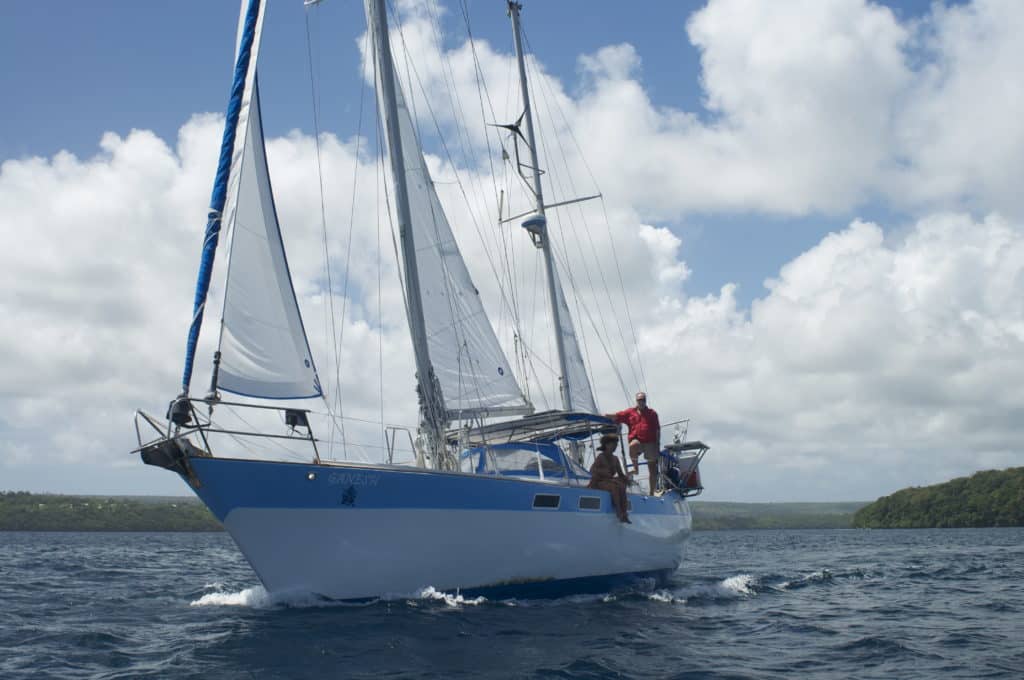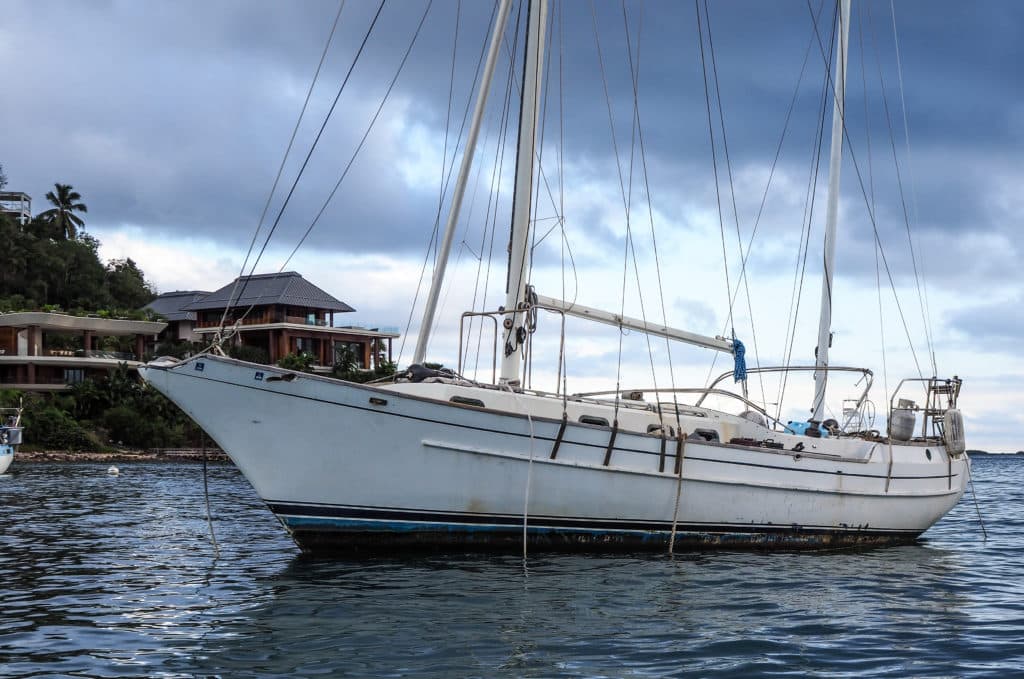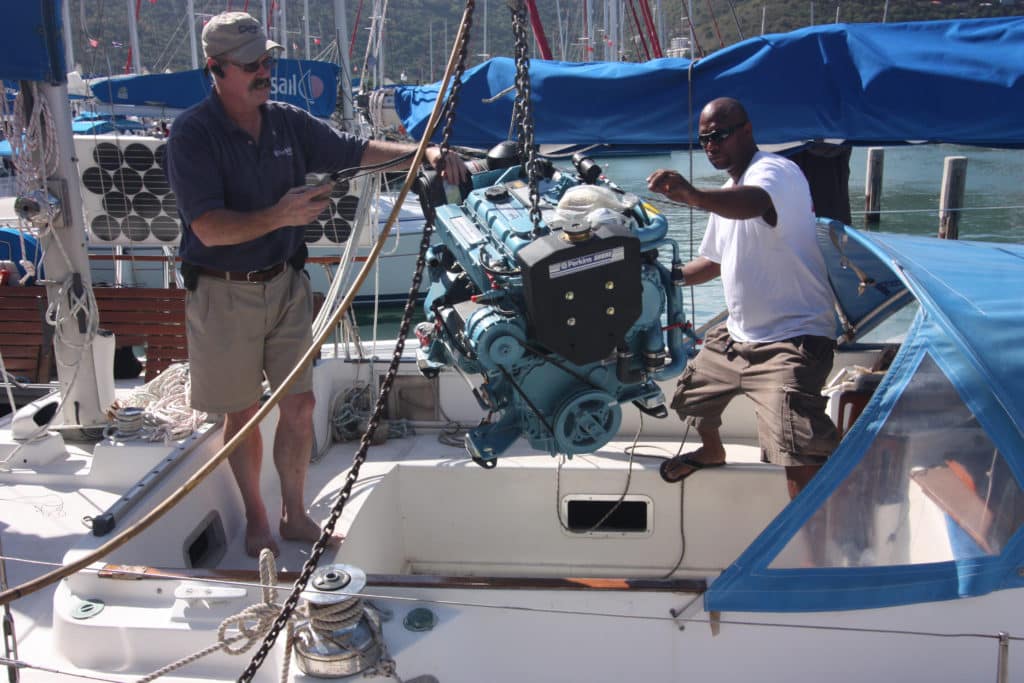
The traditional approach to boat purchasing works well for a certain type of buyer: They identify the type of craft they want, research selected models, visit a broker and, with the help of a surveyor, close the deal. I have no problem with this method. It’s how the majority of cruising vessels are procured today. As I said, it works well for a certain type of buyer — one with money.
Alas, not everyone has a pile of dough idling away in the bank. They might be young or old. Illness might have stolen their retirement nest egg. There are many reasons why good people aren’t among the wealthy: bankruptcy, accident, divorce and an economic downturn are just a few. Even the most successful entrepreneurs are often only one miscalculation away from the poorhouse.
Don’t despair, you there. The reader with empty pockets and a big dream is the very sailor I write for. And I have good news: Money is only one coin of the realm.
I’ve always had, and currently have, empty pockets, yet I’ve sailed hundreds of thousands of miles offshore and circumnavigated three times in safety and comfort. And so, I have good news for you. Sailors at the outset mistakenly think new boats are less trouble than old boats because new cars are more reliable than old ones. This is often false. Many new boats come loaded with problems that will bedevil their owners forever. If you don’t believe me, just ask the owner of a $3 million sailboat who complained its keel was wobbling. The reputable company that built the yacht scoffed. Then, a few months later, on a calm day off the coast of Spain, the keel fell off and the boat sank within minutes.
Oops.
Had the safety of his family truly been a priority, that buyer would have been much better off purchasing a trashed-out Westsail 32 for $10,000.
Honestly, it’s a buyer’s market because of the aforementioned new-boat preference, and because so many old boats still have sound bones and refuse to go away. You just have to find the right one.
Many bargain-hunting, low-end-cruising-boat buyers make a horrible mistake. They are looking in the wrong place, as I discovered when I purchased Ganesh, our 43-foot Amphitrite ketch built by Henri Wauquiez.
Since I had only saved up $40,000 during circumnavigation number two, I was stupidly looking at boats advertised for 50 grand and under. (Yes, one of the reasons we sail around the world is to save the money that shore-bound wage slaves can’t afford to put away toward a new cruising boat.) Silly me. I now know better. Every boat has an asking price and a selling price, and the difference is in the mind of the owner. A (used-boat) sticker price of multiple times what I have in my pocket wouldn’t scare me off now, and it shouldn’t scare you either. Toss out an offer and see what happens. The worst is the owner will say no.
OK, let’s get down to the step-by-step process of obtaining a good boat cheap or a cheap boat free. First, be realistic. You need to forget about buying a boat that’s actually worth $100,000 for $10,000. That’s not going to happen. You can dream about it, but a dream without a plan is just wishful thinking.
We want results. We want a real boat. So, instead of looking for a miracle to drop out of the sky in the form of a well-found Peterson 44, we’re going to look for a worthless boat.
Yes, I said worthless.
Money is, by universal agreement, worth something. Nobody is going to trade something for nothing; it is not in their best interest.

Thus, you need to find a worthless boat.
So here’s that good news: There are tons of worthless boats for sale. How do I know? Because they aren’t selling. They are, after a year or two on the market, by definition, worthless because no one wants to trade something of value (money) for them.
Let that sink in for a while.
Forget what banks say, or what brokers say, or, even crazier, what surveyors are paid to say; look at the marketplace. The hard truth is boats that don’t sell are worthless, or at least worth less than the asking price. Boats that don’t sell are also a continuing and increasing burden on their long-suffering owners, who eventually, to add insult to injury, may have to pay for their dismantlement and disposal.
This is simple Economics 101.
So now that you’ve grasped the concept that the marketplace reveals a boat’s true worth, I’m going to give you another one: Money is, as previously stated, only one coin of the realm. Sweat equity is another.
My Amphitrite 43 entered the market at $140,000, which was high, according to the tire kickers. Not so, said the outraged owner, who had originally paid that amount and then spent an additional hundred-grand on new gear and substantial improvements. (Yes, the legitimate receipts from yards around the world were produced.)
Nonetheless, other models of the same boat were selling for $100,000, and the trickle of buyers ceased. Years went by; four, to be exact. The engine froze. The rudder ceased to turn, and ditto many of the winches. The electronics gradually shut down and the battery banks died. The watermaker packed it up. Hoses cracked. Wires corroded. Swages burst.
Basically, everything stopped but the bills: the yard bill, insurance bill, maintenance bill, water bill, electric bill, poppet rental, etc.
I entered the scene, smiled and said, “I like the boat. We’re close, only one digit off. You’re asking $140,000, and I have $40,000. What do you say we save time and you take in some money instead of continuing to pay it out, year after year after year?”
They were outraged. They were insulted. They screamed, they hollered, they moaned. I got up and left the room. They followed me into the parking lot, bellowing with annoyance, and I knew then and there they were going to sell me the boat, that it was only a matter of time. People who follow you into the parking lot are motivated sellers; owners who don’t, aren’t.
The next day they called me and said the price was firm. I surprised them by saying, “OK, perhaps I was hasty. I like the boat, as I said. I’ll pay $140,000 for her if you bring her up to turnkey condition; install a new Perkins M92B diesel ($40,000); replace the missing genset, which was torn out ($12,000); remove the rig and replace the crushed mast step ($2,000); unfreeze the rudder ($5,000); install a new watermaker ($5,000); replace the dead autopilot ($7,000); redo the standing rigging ($8,000); and rewire her according to ABYC electrical standards ($12,000). Oh yeah, and replace all the cockpit instruments that were looted over the years ($6,000). That would come to $97,000 and leave only $3,000 for you to oversee the work for the next couple of years, assuming nothing goes wrong. That $100,000 plus my $40,000 is your asking price, right? Or you could just sell us the boat for $40,000 and we’d do all the work and worrying. It’s same-same, really.”
A week later, we bought Ganesh for $56,000. It was a reasonable buy on a very well-constructed craft.
So that’s how to buy a good boat cheap, which does not help if you have empty pockets.

Give up? Never!
Here’s how to get a cruising boat for free, step by step.
Find a copy of a year-old classified boat magazine for your area. Start haunting the “boneyards” of your local shipyards, namely the boats whose owners have stopped paying their bills. Ditto the local marinas and any local farms that might have a half-disassembled Carl Alberg 35 collecting dust in a barn. What you are looking for is this: discouraged owners who failed to sell their boat.
Then narrow the list to cruising boats you’d like to buy.
Further narrow the list of discouraged sellers to boats with a major problem, such as a sailboat missing its rig, rudder or engine. Or one that’s been holed, or had a small fire in the engine compartment, etc.
Lastly, limit the list to deals with a ticking clock. The farm where the boat is located is being sold; the marina demands the vessel’s removal within the month; divorce looms; somebody is going to jail. My sister Carole paid pennies for Miz Bligh, her graceful fiberglass Kenner ketch, because she purchased it on a Friday and it had to be removed from the sold-unit condo dock by Monday, but the boat had no rudder. Actually, the silly sellers just thought it had no rudder. It had merely slipped down and was stuck in mud. I fixed it in three or four minutes and sped away that Sunday afternoon.
Once you find a boat you lust after with a major problem and a ticking clock, go find the owner, cast yourself at his or her feet and honestly start crying. Do not tell the owner their worthless boat is worthless if you have no money; tell them exactly the opposite. Tell them that you too love the boat just as much as they did; that you too want desperately to sail it around the world; that you too would still love to have the dream come true however possible; and that you would be happy to invite them to Tahiti or New Zealand or Borneo to visit. Then mention that you have no money and thus have to pray for a miracle, and ask does the owner happen to have any miracles in his pocket, pretty please?
Pie in the sky? Nope. Hundreds of people have acquired solid, if neglected, cruising boats by employing this revive-the-dream approach that I’ve outlined in my Buy, Outfit, and Sail book. Don’t believe me? Ask the proactive, highly personable Christopher Adams, of North Florida, who followed these steps to be gifted a 20-foot Balboa, purchase a Westerly 26 for $400 and, wonder of wonders, have an old duffer lay a perfectly sound Ericson 35 Mark II on him for $1,000 cash.
Here’s the sobering truth of it: Not all dreams reach fruition. But just because your neighbor failed to sail to Tahiti, there’s no reason you can’t. And many of those same neighbors have boats that have become, for one reason or another, essentially worthless.
These owners may have given up the dream, but you can reignite it in a slightly different fashion: You can help them help you make it happen. People are good. Many of them want you to succeed, even where they failed. All you need to do is apply some sweat equity and a ton of chutzpah.
Goofy? Nah. I know of which I speak. I grew up aboard the $100 Elizabeth, sailed away with my wife, Carolyn, aboard the $200 Corina, crossed my first ocean on the home-built Carlotta and circumnavigated twice on the $3,000 Wild Card (at a cost of 3 cents an ocean mile).
Life can be sweet, especially if you live on a boat in a big ocean while spending the pennies Scotsmen throw away.
– – –
Cap’n Fatty and Carolyn Goodlander are drifting around the Virgin Islands in a happy daze after completing their third circumnavigation. What are their plans? “We’d be nuts to stop now,” says Fatty.








